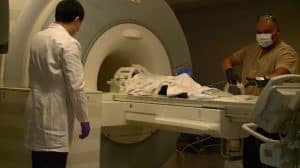The brain is a marvelous mystery, one of the great frontiers of modern medicine. When the brain and all of its subtleties are functioning normally, it’s an amazingly efficient control center. But for people suffering from neuropsychiatric disorders, the anxiety, depression, manic mood swings or memory loss can be devastating. Less than 10 percent of therapies that work in current animal models make it all the way to humans.
The critical need for better therapies is the reason scientists at Texas Biomedical Research Institute are working on new ways to understand human brains – by learning more about the brains of non-human primates, specifically baboons.
Hundreds of baboons are part of a colony at the Southwest National Primate Research Center on the Texas Biomed campus. Their size and their genetic similarity to people make them a good animal model for all kinds of scientific comparisons. Scientist Dr. Melanie Carless is the principal investigator.
“The baboon brain’s probably one of the most similar brains to humans in terms of the gyrification or the folding of the brain, also in terms of the different structures and regions within the brain that might correlate to neuropsychiatric disorders,” explained principal investigator Melanie Carless, Ph.D.

A grant from the National Institutes of Health is funding a two-year study to provide evidence for the use of baboons as a preclinical model for neuropsychiatric diseases. The idea is to determine a biomarker signature of structural variations in the brains of baboons. Those variations may correlate to conditions.
In order to peer into the baboon brains, Texas Biomed is teaming up with the Research Imaging Institute at the University of Texas Health Science Center at San Antonio. Male and female baboons of different ages are scanned in a magnetic resonance imaging machine.
Incredibly precise MRI images give researchers a detailed look at the structure, size and blood flow in different areas of the brain. Those results will be compared to biomarkers in the animal’s bloodstream.
“We’re trying to identify biomarkers, so peripheral biomarkers that might reflect changes in structural or functional variations within the brain,” Carless said. “We’re looking at something called microRNAs. And these are very small RNA molecules that regulate a very large portion of the genome and of the proteins that are made from the genes. And so by trying to identify microRNAs that might be present in the blood or in the plasma and seeing if they also correlate or they’re associated with variations in the brain, that can start to give us a clue into whether these microRNAs might be biomarkers not only of brain structure andfunction but also of psychiatric diseases.”

This kind of project is no small undertaking. First, using a 3-D printer, researchers rendered replicas of male and female baboon heads. They devised MRI surface coils – smaller helmets to fit closely to the animals’ heads. During the scan, the animals themselves are sedated and carefully monitored by animal specialists tracking body temperature, respiratory and heart rates, and oxygen levels.
The data collected from more than 30 animals over two years will likely lend insight into what has been an elusive medical issue: finding effective medications for patients.
Dr. Carless says this work is important since one in five Americans suffers from some degree of mental illness. “This is something I’m passionate about really because when we look at psychiatric diseases, they’re very common,” Carless commented. “They can be very devastating. And they affect a large portion of the population.”
By developing a better model for these complex diseases, the idea is to speed up clinical trial successes and get better therapies to the people who so desperately need them.